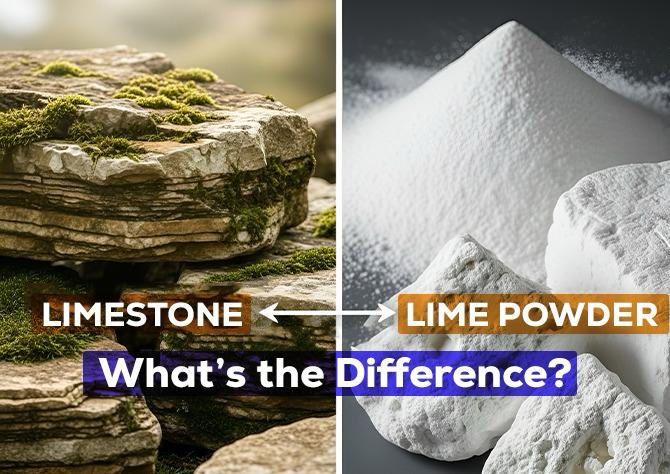Here are two words for you today: lime and limestone. You might think that they are both the same words, i.e., their meaning is the same. And you are not wrong. After all, lime comes from limestone eventually. Well, in reality, they have different forms, compositions, and applications. Understanding the difference between the two is key not only for students and researchers, but also for industries like steel, chemicals, paper, and construction. In this blog, we’ll explore what each term means individually and how their differences align.
What is Limestone?
Limestone is a naturally occurring compound in the form of a sedimentary rock, formed over millions of years from the accumulation of shells, coral, and marine life. Chemically, it’s known as calcium carbonate (CaCO3). For reference, you’ll find the best limestone manufacturers in Rajasthan are ancient-holders, reestablishing the natural specificity of limestone.
- How does it look? A white, grey, or cream-colored rock.
- How is it made? Occurs naturally in quarries or is mined as a raw material.
- How is it represented chemically? CaCO3 with some amounts of silica, magnesium, or clay present (varies with source).
Uses:
- Building material (blocks, slabs, aggregates).
- Raw material in cement and concrete production.
- As a flux in the steel industry to remove impurities.
- For road base and railway ballast.
- As filler in paints, plastics, and rubber.
What is Lime?
You will not find just “lime” anywhere naturally. It’s a byproduct of heating limestone at very high temperatures (going as high as 1000°C) in kilns. The process is termed “calcination,” and drives out large fumes of carbon dioxide (CO2), creating a highly reactive substance.
Commonly-Used Types of Lime:
- Quicklime (CaO): First form obtained from calcination; also called burnt lime. High water-reactivity.
- Hydrated Lime (Ca(OH)2): Quicklime + Water. Easy handling and used across industries.
Uses:
- As a flux in the steel and non-ferrous metal industries.
- In water treatment, to soften water and remove impurities.
- In the paper industry, for bleaching and brightness control.
- In the chemical industry for producing caustic soda, petrochemicals, and fertilisers.
- As a neutralising agent in pollution control and flue gas treatment.
Limestone vs Lime
| Feature | Limestone | Lime |
| Form | Natural rock (sedimentary) | Processed product from limestone |
| Chemical Composition | CaCO₃ | CaO (quicklime) or Ca(OH)₂ (hydrated lime) |
| Appearance | Hard rock, grey/white | Powder or lumps, white |
| Production | Mined directly | Produced by heating limestone |
| Reactivity | Stable, low reactivity | Highly reactive (especially quicklime) |
| Main Uses | Cement, construction, aggregates, filler | Steelmaking, chemicals, paper, water treatment |
Why is it Confusing for People?
The simple reason people confuse lime for limestone or vice versa is that lime originates from limestone. While vaguely, you might be right in saying that they both are the same since they are both used in construction and industry, their purposes differ:
- Limestone provides bulk and stability to buildings, roads, and cement.
- Lime provides reactivity and chemical action to steel refining, water purification, and chemical processes.
Common Applications
Limestone
- Crushed to use in cement and as aggregate in roads.
- As a flux to remove impurities from steel.
- As a filler to improve the paper’s quality.
- To desulfurise the smoke (and make it less harmful) emitted by factories.
Lime
- Stabilises the soil and improves mortar (mixture used for construction) durability.
- Improves the overall refining and helps in slag management.
- Hydrated lime is used in bleaching and improves paper shine.
- Hydrated lime is used to enhance the quality of water and pollution management.
Conclusion
Yes, lime and limestone are very similar. But are they the same? No! They are different in their form, chemical composition, and production.
- Limestone = Natural, stable, calcium carbonate rock.
- Lime = Processed, reactive, and industrially versatile material.
This blog will serve as a comprehensive refresher for students, researchers, professionals, and industries, highlighting the differences between compounds and guiding them in making the right choice.
Frequently Asked Questions (FAQs)
Which is better for construction?
Depends. Limestone is used in cement and aggregate. Lime is better for soil stabilisation and mortar.
Can limestone be used instead of lime?
Yes, but not always. Lime is required in chemical and industrial applications due to its reactivity.
Why is lime more expensive than limestone?
Lime suppliers in Jodhpur accrue this difference due to additional processing (calcination, hydration) required for lime.

